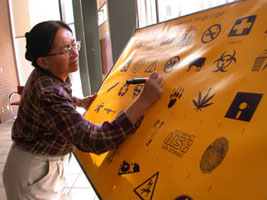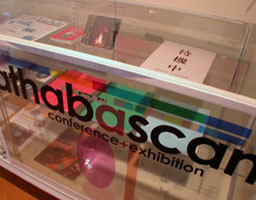About exhibition
|
||
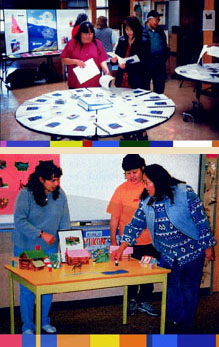 To the right is a photograph of an exhibit of publications by the Yukon
Native Language Center that was held in Whitehorse, Canada last June.
The photograph to the lower right shows the games used in classes at the Native Language Center. The aim of this exhibit is to introduce such
efforts by Athabascan people to revitalize their traditional languages
and cultures. Far from being a staid museum exhibition, this exhibit
takes its inspiration from the colors, forms and ideas of the two
exhibits in these photographs. To the right is a photograph of an exhibit of publications by the Yukon
Native Language Center that was held in Whitehorse, Canada last June.
The photograph to the lower right shows the games used in classes at the Native Language Center. The aim of this exhibit is to introduce such
efforts by Athabascan people to revitalize their traditional languages
and cultures. Far from being a staid museum exhibition, this exhibit
takes its inspiration from the colors, forms and ideas of the two
exhibits in these photographs.
The lively colors used in this exhibit and the posters for the exhibit reflect the theme of revitalization. The international conference entitled, "The Role of Intercommunication in Athabascan Revitalization," which was held in conjunction with the exhibit, was also based around this theme. Revitalization can be interpreted in many ways but the image of revitalization realized by this exhibit was inspired by one single photograph. 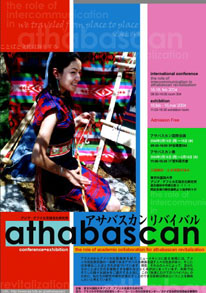 The planning and preparations for the exhibit began at the end of
January with the arrival of a single photograph through e-mail. It was
a photograph of a young Navajo woman happily weaving in the sun on a
bright spring day. Her lively expression and the vivid red and blue
centered color scheme were compellingly refreshing. (On a side note,
this woman is actually the daughter of the one of the international
conference panelists, Martha Austin). This bright and energetic image
became the leitmotif of the exhibition. The poster for the exhibit
takes the colors from the photograph and repositions them. In other
words, it unravels the strands of color from the woven image of the
photograph and reweaves them. By making it resonate with the original
image, we have tried to revitalize the original into something new and
full of life. Thus, this exhibit is an artistic expression through
design of the theme of the international conference, "The Role of
Intercommunication in Athabascan Revitalization." The planning and preparations for the exhibit began at the end of
January with the arrival of a single photograph through e-mail. It was
a photograph of a young Navajo woman happily weaving in the sun on a
bright spring day. Her lively expression and the vivid red and blue
centered color scheme were compellingly refreshing. (On a side note,
this woman is actually the daughter of the one of the international
conference panelists, Martha Austin). This bright and energetic image
became the leitmotif of the exhibition. The poster for the exhibit
takes the colors from the photograph and repositions them. In other
words, it unravels the strands of color from the woven image of the
photograph and reweaves them. By making it resonate with the original
image, we have tried to revitalize the original into something new and
full of life. Thus, this exhibit is an artistic expression through
design of the theme of the international conference, "The Role of
Intercommunication in Athabascan Revitalization."
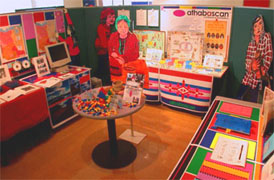 Another characteristic of this exhibit is that it is a work in progress.
The exhibition is not a completed work but was planned as a work that
would stay in progress, continuously expanding and transforming
throughout the period of the exhibit. For instance, blank spaces and
columns and empty display cases were prepared for that purpose. It was
hoped that the blank spaces would be filled by the Athabascan people who
participated in the international conference. Showing the process
itself of the blank spaces being filled little by little through this
'intercommunication' is another aim of the exhibit. Another characteristic of this exhibit is that it is a work in progress.
The exhibition is not a completed work but was planned as a work that
would stay in progress, continuously expanding and transforming
throughout the period of the exhibit. For instance, blank spaces and
columns and empty display cases were prepared for that purpose. It was
hoped that the blank spaces would be filled by the Athabascan people who
participated in the international conference. Showing the process
itself of the blank spaces being filled little by little through this
'intercommunication' is another aim of the exhibit.
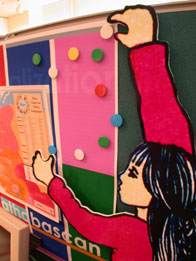 This plan is happily being realized. Photographs now cover the blank
spaces of the exhibit panels, and words fill the blank columns. For
several days in a row Athabascan songs and stories were performed in
the exhibition space and the participants provided explanation for each
of the materials on display (a video of these events is currently being
made). This plan is happily being realized. Photographs now cover the blank
spaces of the exhibit panels, and words fill the blank columns. For
several days in a row Athabascan songs and stories were performed in
the exhibition space and the participants provided explanation for each
of the materials on display (a video of these events is currently being
made).The display cases that started off empty are now full, and the exhibit itself has been revitalized. The exhibit was conceived as a work in progress because language and culture transcend time and space, and are themselves ever-changing (and traveling) and never-ending works in progress. Perhaps this is what the revitalization movement has taught us above all. |
| ▲Exhibition top | About the Exhibition Panels▼ | About the Video▼ | About the Calendar▼ |

